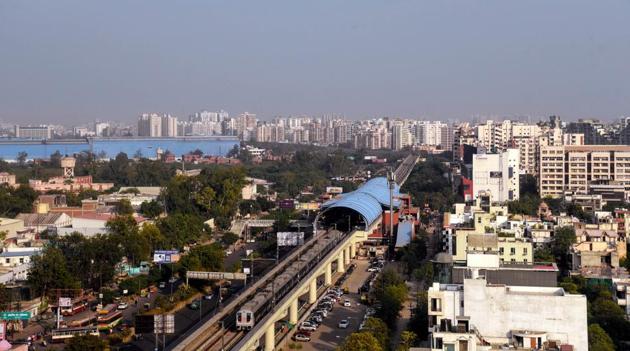Focus on local emissions to avoid return of bad air
VK Soni, head of India Meteorological Department’s (IMD) environment monitoring research centre, said the western disturbance, which started impacting the western Himalayas on Sunday brought widespread and moderate rains to Delhi-NCR, helping Delhi breathe cleaner air.
Rain and improved wind speed after Diwali, which cleared off much of the pollution accumulated due to heavy stubble burning in Punjab and Haryana and the cracker bursting in the city, might have given Delhi the much-needed boost going into the winters when the air quality plunges every year. However, experts cautioned that the authorities must focus on local sources to ensure that city does not slip into an air emergency again.

VK Soni, head of India Meteorological Department’s (IMD) environment monitoring research centre, said the western disturbance, which started impacting the western Himalayas on Sunday brought widespread and moderate rains to Delhi-NCR, helping Delhi breathe cleaner air.
“The number of stubble fires being spotted over Punjab and Haryana are nearly negligible now. With this western disturbance, two major polluting episodes have been taken care of, which means that now local pollution sources and local weather factors will be the contributors for any kind of change in air quality,” Soni said.
Also Read: Noise pollution up from last year
Analysis of AQI data shows that on Tuesday for the first time since 2017, Delhi experienced a moderate air quality day between November 13 and 17.
Delhi’s average air quality index (AQI) on Tuesday was recorded at 171, in the moderate zone, according to the Central Pollution Control Board (CPCB) data. Also, the contribution of stubble fires in the city’s PM 2.5 levels (ultrafine particulate matter with diameter less than 2.5 micrometres) was just 3%. It had peaked to over 40% in October.
Experts said that while sharing a common air shed, pollution coming in from neighbouring states contributes to the air quality deterioration in Delhi, but local factors cannot be ignored.
Anumita Roychowdhury, executive director (research and advocacy), Centre for Science and Environment) said that while Delhi has been successful in bending the pollution curve year-after-year, a lot still needs to be done to control pollution, especially in the areas of vehicular emissions and waste management.
“There is no denying that work has been done in areas such as controlling industrial emissions and fumes from heavy vehicles crossing the city, etc, but there are still two primary areas where efforts are required. One is reducing vehicular emissions, for which authorities will have to go back to basics and work towards the augmentation of public transport. The situation has become a little tricky now with the limitations due to Covid-19, but this should be a long-term goal for the government,” Roychowdhury said.
Also Read: Rain and winds help Delhi breathe a little easy
She added, “Another area where the government needs to concentrate is waste management. In many unauthorised areas there isn’t a proper system to dispose household waste and this waste ultimately ends up being thrown in dhaloas and set ablaze.”
Delhi’s environment minister Gopal Rai on Tuesday said the government is controlling local pollution sources and that Delhi’s air quality cannot be looked at in isolation.
“We have said this time and again, we are not denying that Delhi’s local pollution sources are a problem, but these sources were the same till August. The deterioration starts when the harvest season starts in Punjab and Haryana and farmers start burning stubble in their fields because they do not have a viable option to get rid of it,” Rai said.
Enlisting the measures being taken by the Delhi government to control the local sources of pollution, Rai said that they had from November 16 started the second phase of ‘red light on, gaadi off’ (red light on, ignition off) campaign, to control the vehicular emissions. He also said that regular meetings are being conducted with the municipalities to ensure that water sprinkling and mechanised sweeping is done to prevent road dust and open burning of waste is controlled.
A 2019 analysis of Delhi’s pollution sources done by Council on Energy, Environment and Water showed that vehicular emissions contributes to as much as 39.2% of the city’s PM 2.5 levels (ultrafine particulate matter with diameter less than 2.5 micrometres). This is closely followed by dust from roadsides, whose contribution goes up to 37.8%. In PM 10 levels (particulate matter with diameter less than 10 micrometres), the contribution of road dust goes up to 65.9%, while the contribution from construction activities reaches 21%.
Also Read: Pollution levels soar on Diwali as cracker ban falls flat in Delhi
Radha Goyal, deputy director, Indian Pollution Control Association (IPCA) also said that vehicular emissions, construction activities and waste burning are the main local sources of air pollution in Delhi during winters.
“The approach to handling winter pollution should be more preventive than responsive. There should be strict monitoring on waste burning by municipalities in Delhi-NCR, and now that we have already practised working from home during the Covid-19 lockdown, this could become a practice during critical winter periods to avoid congestion on roads. Stricter guidelines and controlled construction activities will also help in reducing the impacts of local sources on Delhi’s AQI during critical winter periods,” Goyal said.
Stay updated with all top Cities including, Bengaluru, Delhi, Mumbai and more across India. Stay informed on the latest happenings in World News along with Delhi Election 2025 and Delhi Election Result 2025 Live, New Delhi Election Result Live, Kalkaji Election Result Live at Hindustan Times.
Stay updated with all top Cities including, Bengaluru, Delhi, Mumbai and more across India. Stay informed on the latest happenings in World News along with Delhi Election 2025 and Delhi Election Result 2025 Live, New Delhi Election Result Live, Kalkaji Election Result Live at Hindustan Times.






